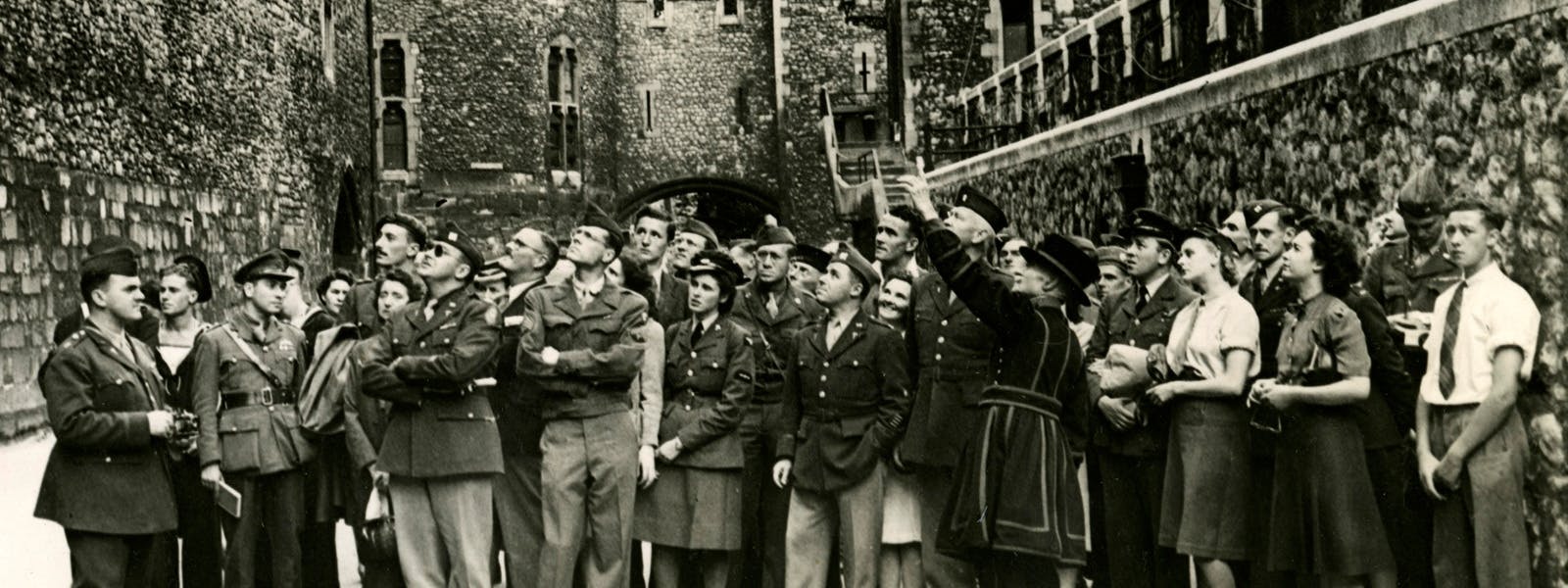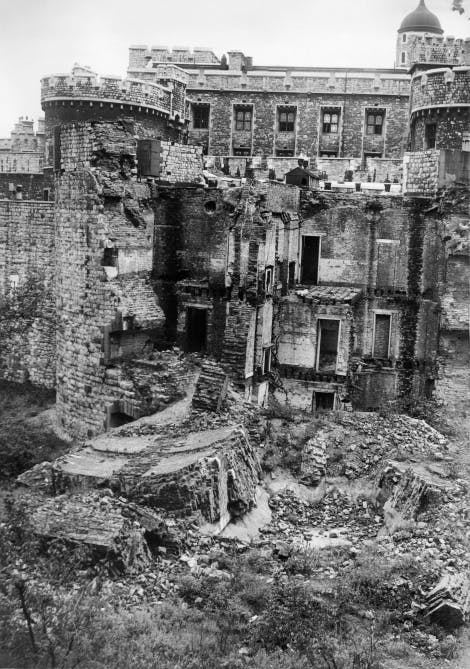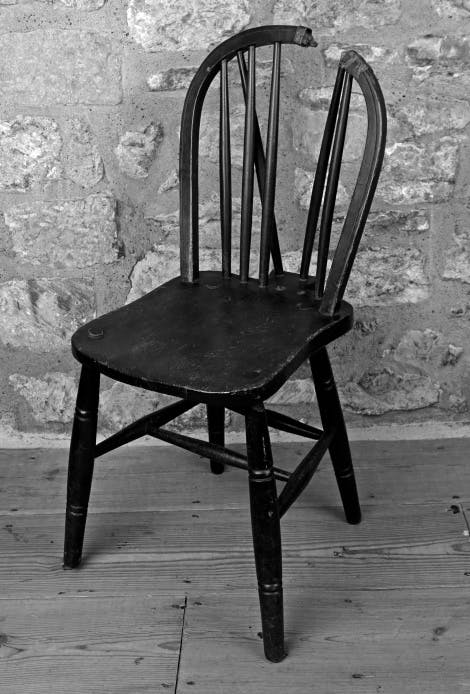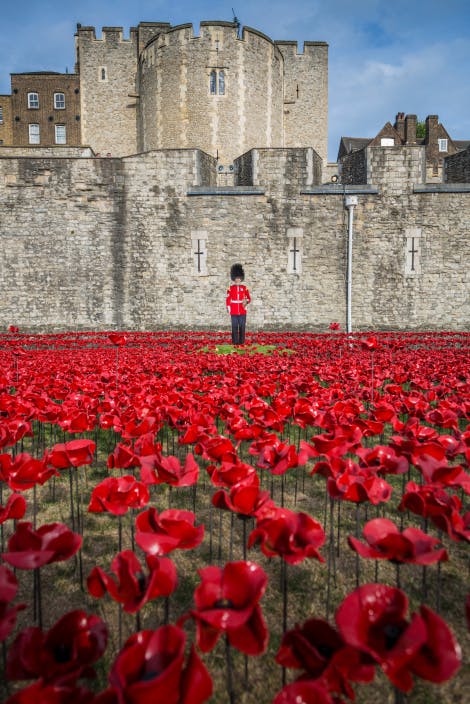
Life at the Tower of London during the Second World War
After the end of the First World War, the Tower of London continued its role as a tourist attraction. Maintaining its military traditions and royal ceremonies, diplomatic visits from around the world took centre stage. But in autumn 1939, tensions loomed, and the prospect of another war became inevitable.
By 3 September 1939, Britain declared war against Germany, marking the beginning of the nation’s involvement in the Second World War. At the outbreak, the Tower of London closed to the public.
This time, the war was closer to home. During the Second World War, the Tower of London faced the threat of bomb damage, and its residents – including the Yeoman Warders, their families and other members of the Tower community – feared for their lives.
Soldiers in the White Tower
At the outbreak of the war, the Tower Armouries, responsible for looking after historic arms and armour at the fortress, removed objects from the collection — including Henry VIII’s armour. Tower residents were issued with gas masks and steel helmets and prepared themselves for regular blackout drills.
By autumn, the vacated galleries in the White Tower were re-purposed for the military. Chambers were used as a sports room and concert hall for troops, with a canteen and library on the ground floor and an air raid shelter in the basement.
The famous execution block and axe were put on display for soldiers, while the Tower Armouries gave lectures and tours. Tours of the Tower were later offered to Dominion troops, as well as British forces and their allies.

Image: In 1940, a barrage balloon was tethered in the Tower’s western moat. These balloons were employed across the city to defend against dive bombers. Later in the war, the balloon was operated by members of the Women’s Auxiliary Air Force. © Heritage Image Partnership Ltd / Alamy Stock Photo
What happened to the Crown Jewels during the Second World War?
During the Second World War, the Crown Jewels were removed from the Tower. At the time, their location remained a mystery to the public, but it has since been revealed the Regalia was secretly hidden away at Windsor Castle.

Image: The Old Hospital Block, Tower of London. © Historic Royal Palaces Image Library
Prisoners of war at the Tower
The Tower Prisoner of War Collection Centre was set up on 3 September 1939 to house prisoners of war for interrogation before they were sent to prison camps.
Wounded prisoners were placed in the Old Hospital Block, south of the Fusilier Museum. Other prisoners stayed in the New Armouries, where the current visitor café stands, and the Main Guard (later destroyed in an air raid), on the lawn in front of the White Tower.
The centre eventually moved to north London, as the Tower ran out of space to detain a large number of prisoners.
Dig for victory!
The government introduced a campaign calling for the public to turn green spaces into allotments.
Lawns, flower beds, sports pitches, gardens, and parks were transformed into vegetable patches, as The Ministry of Agriculture urged the British people to ‘Dig for Victory!’
The propaganda campaign aimed to make sure people had enough food and to keep morale high.
Britain imported a great deal of its food and German U-boat attacks on merchant shipping exposed the public to the threat of starvation.

Image: Yeoman Warders Burrows (foreground), Stevens and Box can be seen 'digging for victory' © Historic Royal Palaces Image Library / Yeoman Warder Archive
The Moat becomes an allotment
Everyone was expected to 'do his or her bit' to help the war effort, as food and other essentials were limited. The Tower of London was no exception. Located in the historic Borough of Tower Hamlets, the Tower joined the East End in following the government’s advice to grow vegetables.
The Tower Moat became an allotment where residents, including Yeoman Warders, planted crops. The Moat had been used to grow vegetables and graze livestock before, as early as the 1890s.
The Moat continues to benefit communities around the Tower. In 2022, it was transformed into a biodiverse landscape to mark the Platinum Jubilee of Queen Elizabeth II.
The Tower of London during the Blitz
The British Government enforced a blackout from 1 September 1939 in expectation of a German civilian bombing campaign.
At first, the Tower struggled to maintain a total blackout, with light escaping through the fortress’s arrow slits. This was rectified by the electrician who on alert would cut off power to the entire Tower.
From 7 September 1940 to 10 May 1941, London and then the rest of the United Kingdom experienced nightly aerial bombardment in what came to be known as the 'Blitz'. The East End of London became a strategic target for the German bombers in a plan to destroy the docks and warehouses that lined the Thames.

Image: The North Bastion after being struck by a bomb © Historic Royal Palaces Image Library / Yeoman Warder Archive
Bomb damage at the Tower
While the only German bomb to fall on the Tower during the First World War landed in the Moat, the aerial bombardment of the Second World War caused significant damage.
On 23 September, high explosive bombs destroyed a large section of the Mint as well as the north section of the Old Hospital Block. The Blitz caused significant damage across the fortress, including to the Moat, the Main Guard and Tower Wharf. Many direct hits also disrupted gas, water, and electricity supplies for the Tower’s residents.
Tragically, some of these raids cost those stationed and living in the Tower their lives. For example, a bomb struck the fortress on 5 October 1940, blowing apart the massive North Bastion and narrowly missing the White Tower.
Yeoman Warder Samuel Reeves and 70-year-old Lily Frances Lunn, who lived with her family in the North Bastion, were killed.
Evacuation of Tower residents
No shelters were dug at the Tower, though some basements were reinforced and used as refuge during air raids. On 10 October, the Yeoman Warders were advised to evacuate their families to the countryside. The Tower continued to face aerial bombardment until the end of the Blitz in May 1941.
By dawn our poor old Tower looked in a pitiful plight, for hardly a portion of it had escaped the fury of the night. Most of its windows had been blown out, or were hanging awry. Glass was strewn everywhere. Doors were off their hinges, ceilings down, and blackout curtains torn to ribbons.
Chief Warder A.H. Cook recalling his experience of an air raid at the Tower on 8 December 1940
Air raid damage at the Tower of London
This plan of the Tower of London records the locations of bomb strikes between September and December 1940.
View this document in high definition in this Gigapixel image, created in partnership with Google Arts & Culture.
Watch footage of the Tower of London bombed (1941)
The video shows the Tower of London the day after a heavy air raid. One of the towers was bombed, causing part of it to collapse. This original footage features shots of piles of rubble in the Moat and Civil Defence Workers scrambling over ruins.
This content is hosted on YouTube
This content may be using cookies and other technologies for which we need your consent before loading. To view the content, you need to enable cookies for "Targeting Cookies & Other Technologies".
Manage CookiesTower of London bombed. Unedited material. London. Various shots of Tower of London, day after heavy air raid. One of the towers has been bombed, causing part of it to collapse. Various shots of piles of rubble in moat. Civil defence workers scramble over ruins. Note: shots are from 1941 Unknowns Can 3 which is same vault as rest of 1941 material. Original issue number for story is unknown. FILM ID:1143.03

Image: Rudolf Hess, c1946 © PA Images / Alamy Stock Photo
Rudolf Hess and the Tower of London
During the Second World War, the Tower again became a prison for high-status prisoners.
The most high-profile of these was Rudolph Hess, deputy Führer of the Nazi party and Adolf Hitler’s right-hand man.
On 10 May 1941 Rudolf Hess flew from an airfield in Augsburg, Bavaria on a solo flight to Scotland. He bailed out from his plane and parachuted into a field outside Glasgow.
Hess’ motive for this mission remains one of the great unresolved mysteries of the Second World War. Some suggest Hess intended, with or without Hitler's permission, to negotiate a peace between Germany and the United Kingdom. Others believe he was lured to Britain by the British Secret Intelligence Service.

Image: During his brief imprisonment at the Tower, he signed a piece of notepaper for a guard. It survives today at the Tower in the Yeoman Warders’ club. © Yeoman Warder Archive
Hess imprisoned in the Tower
Hess was captured and taken to the King's House at the Tower of London on 17 May 1941, where many prisoners had been interrogated, including Guy Fawkes.
Lodged under the tightest security, he was held for four days until he was removed from the Tower. He spent the rest of the war as a prisoner at Mytchett Place, Surrey.
At the Nuremburg Trials of 1946, Hess was sentenced to life imprisonment in Spandau, west Berlin, where he remained until his death in 1987, aged 93.
Hess was one of the last state prisoners to be held at the Tower.

Image: Photograph of Josef Jakobs. © Giselle K. Jakobs
Josef Jakobs: The last spy to be executed at the Tower
Josef Jakobs was the only spy to be executed at the Tower during the Second World War. He was also the last person to be sentenced to death inside the Tower’s walls.
Jakobs was conscripted into the German army during the First World War, where he was shot in the chest on duty. He recovered and worked as a dentist. When the Nazi Party rose to power, he sold black market passports to Jewish people fleeing the country. He was eventually arrested by the Gestapo in 1938.
After two years, Jakobs was released in exchange for his services as a spy in England. Like many spies in the First World War, Jakobs was not suited for espionage, but the government needed agents for risky missions.
Jakobs allegedly confided to a friend that he planned to help the British Intelligence so that he could secure safe passage to America.
Jakobs's capture in England
Jakobs was captured on 1 February 1941 by two farmworkers after he was injured whilst parachuting into England.
He claimed he had arrived from Hamburg and wasn’t part of the war, but he was found with a wireless transmitter, a small torch with a flashing device and a map that marked the nearby positions of the RAF aerodrome in Upwood Village and the satellite airfield in Warboys Village.

Image: Josef Jakobs was executed in this chair, which is still on display in the White Tower. © Royal Armouries
Jakobs's execution at the Tower
While awaiting his fate, he wrote to his wife, Margarete, ‘Dear, best wife, thousands and thousands of times over, thank you for all the good you have done for me.’
He ended the letter with ‘Aufweidersehn’, meaning ‘until we see each other again’.
Jakobs was executed on 15 August 1941 in the miniature rifle range, the same location Carl Hans Lody and eight other spies were executed during the First World War. With his last words, Jakobs told the ‘Tommies’ to ‘shoot straight’.
He was buried in an unmarked grave in St Mary’s Roman Catholic Cemetery in north-west London.

Image: The Tower of London floodlit during the VE Day celebrations, on May 8, 1945. © Associated Press / Alamy Stock Photo
What happened at the Tower after the Second World War?
VE Day Celebrations across London
On 8 May 1945, allied forces declared ‘Victory in Europe’; the celebrations that followed became known as VE day. To mark the occasion, the Tower was illuminated with floodlights, and the East End of London celebrated with a week of street parties, although the shadow of all the lives lost hung over the festivities.
The war against Japan continued and many soldiers were still serving overseas. The effects of the war would be felt for many years.

Image: Visitors return to the Tower after the end of the Second World War. The remains of the Main Guard building can be seen on the left. © Historic Royal Palaces Image Library
The Tower reopens
The Tower re-opened to tourists in 1946, although the bomb damage from the Blitz was highly visible and yet to be cleared.

Image: Yeoman Warder Ford leading a group of visitors through the Tower on the first day the site was reopened. © Historic Royal Palaces/Yeoman Warders Archive
How does the Tower remember the war?
The Tower of London had adapted and transformed into many roles during the Second World War.
From turning the Moat into an allotment for the ‘Dig for Victory’ campaign to enduring London’s air raids, the fortress also resumed its function as a site of imprisonment and execution.
Today, the legacy of war and its effect on the Tower and its communities is remembered in a pair of Commonwealth War Graves Commission memorials on Tower Hill.
The memorials commemorate the First World War (built in 1928) and the Second World War (created in 1955), honouring civilian and merchant seafarers who were killed during the war and have no known grave. The memorials were devised by Edwin Lutyens, the architect responsible for designing The Cenotaph in Whitehall.
Watch: How the Tower of London survived the Second World War
What was life like in the Tower of London during the Second World War, and how did the fortress survive this threat?
Explore this fascinating history of the Tower in this short video with our expert curators.
Watch on YouTubeThis content is hosted on YouTube
This content may be using cookies and other technologies for which we need your consent before loading. To view the content, you need to enable cookies for "Targeting Cookies & Other Technologies".
Manage CookiesWhat was life like in the Tower of London in wartime, and how did the fortress survive this threat?
Video transcript of How the Tower of London Survived the Second World War
Follow along with an interactive transcript of this video on YouTube. A link to open the transcript can be found in the description.
Browse more history and stories

The Tower of London and the First World War
The Tower of London played an important role in the First World War

Tower of London remembers
First World War centenary commemorations at the Tower of London

Elizabeth II at our palaces
Elizabeth II had a deep connection to the Tower of London and the other five palaces in our care
Explore what's on

- Things to see
The Crown Jewels
Discover the dazzling history of the Crown Jewels in the spectacular Crown Jewels exhibition.
-
Open
- Allow one hour
- Tower of London
- Included in palace admission (Members go free)

- Tours and talks
Ceremony of the Keys
Be part of this ancient tradition, which has taken place every night for at least 700 years in the Ceremony of the Keys at the Tower of London.
-
Daily
- From 21:30-22:05
- Tower of London
- Separate ticket (advance booking required)

- Things to see
Battlements
Walk the defensive walls and huge towers that have guarded the Tower of London for centuries.
- Open
- Tower of London
- Included in palace admission (Members go free)
Shop online

Shop Kings & Queens of England
Discover our informative and best selling range, inspired by the incredible history of the Kings and Queens of England.
From £4.99

Shop Hanging Decorations
Browse through our beautiful range of hanging decorations, ornaments and baubles including unique and hand-made pieces.
From £5.50

Tower of London Navy Raven Sweatshirt
Inspired by the infamous ravens of the Tower of London, this sweatshirt will keep you warm on those chilly days.
£38.00
